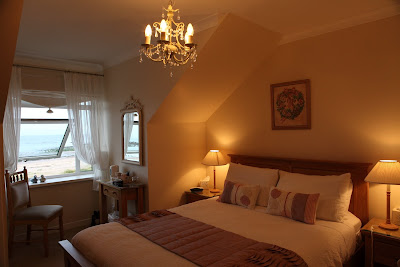Ask someone what comes into their heads when you say "British coast", and chances are they'll mention the white cliffs of Dover. (I think I would!?) For centuries, the cliffs were the first thing international travellers saw, arriving on passenger ships from the continent.
Today it is still a major port, with ferries leaving every few minutes to make the 21 mile crossing to France. And the best place to see them coming and going is
Dover Castle, perched on the hill above town. It is a superb spot. The castle is imperious, with 270-degree views of the coast. It's been a very important military stronghold since its beginnings nine centuries ago. Indeed, it's always been known among army men as the "key to England".
 Dover Castle to the left, Roman lighthouse and St Mary's Chapel in the centre, and Dover harbour to the right...click for a full screen version.
Dover Castle to the left, Roman lighthouse and St Mary's Chapel in the centre, and Dover harbour to the right...click for a full screen version. Dover Castle...
Dover Castle...The iron age folk used it as a fort, and then the Romans built a huge lighthouse, which still stands today next to St Mary's chapel on the castle grounds. And the castle has been garrisoned continuously from 1066, when William the Conqueror built the first version of the castle, to 1958. Only the Tower of London and Windsor Castle can claim likewise.
It's a worthwhile visit. There are three things you shouldn't miss. First, Dover Castle itself. It's very well preserved...perhaps more so than any other castle I've seen on my trip. Make sure you walk to the top of the Great Tower in the centre, for fine views.
Second, St Mary's chapel next to the Roman lighthouse...the chapel is one of the oldest in the land. It's also got the best view across the channel.
And third, do the Secret Tunnel tour...
When Napoleon and the Brits locked horns in the late 1700s, the army built a vast network of tunnels underneath the castle, to house up to 2000 soldiers. No threat really materialised, but the engineers of the time could never have known how important their work was to become.
During World War II, the tunnels served as the bomb-proof command centre for Operation Dynamo. In May 1940, hundreds of thousands of Allied troops were cornered by the advancing Germans on the northern beaches of Dunkirk in France. The Britisn army's survival was at stake. The navy was tasked with getting them off the continent and back home, so they could fight another day.
From the tunnels the senior naval staff commandeered close to 700 ships, and in nine days more than 300 000 troops were rescued. The ships comprised naval vessels, fishing boats and any number of volunteer leisure boats. It came to be known as the "miracle of Dunkirk," because initially it was thought that only 90 000 troops could be rescued.
The Tunnel Tour will let you see what it was like for those naval officers, as well as the doctors and nurses that worked in the underground make-shift hospital.

 Trying to look like Churchill...the Prime Minister came to Dover Castle to monitor the Battle of Britain.
Trying to look like Churchill...the Prime Minister came to Dover Castle to monitor the Battle of Britain...
Soon afterwards, the castle's tunnels were used again to monitor the Battle of Britain (July to October 1940). Winston Churchill watched the Spitfires and Hurricanes dogfight with the Luftwaffe's planes, knowing that the war's outcome depended more on this battle than perhaps any other. For it was Hitler's intent to invade Britain across the channel, landing 60 000 German soldiers on the 21st September 1940 between Dover and Brighton. The Nazi leader knew that air supremacy was crucial to the success of his naval operation, so he sent hundreds of planes across the channel to destroy the British air bases.
Three thousand British pilots in 20 squadrons were waiting for them, and the battle reached its climax on the 15th September 1940, when 85 German aircraft were destroyed or seriously damaged, and only 26 Royal Airforce planes were shot down. It was one of the turning points in the war, and led Churchill to praise his pilots with perhaps an incomparable commendation: "Never in the field of human conflict was so much owed by so many to so few."
Almost 600 Allied pilots died during the Battle of Britain, and more than 800 died later in the war.
And that's why the most memorable thing you can do is visit the Battle of Britain Memorial on the coastal road between Dover and Folkestone. On top of the cliffs is a statue of a young pilot, sitting, waiting...pensive and silent, alone. He's looking out to sea, across to France...watching for German planes, ready for the call to jump into his Spitfire or Hurricane. It's a powerful experience...and brings home the sacrifice that each pilot had to make during those few weeks in 1940.
The names of all the pilots who fought in the Battle of Britain are engraved on a wall behind the statue, and nearby is "Bob", a statue of one of the squadron dogs, who's also looking attentively out to sea, waiting for his pilots to come back safely.
Dover Castle is a great visit, but the Battle of Britain Memorial is more impressive, despite it's simple design and slightly run-down state. (It's maintained by volunteer money, so make sure you donate when you're there!)
The Battle of Britain Memorial between Dover and Folkestone...
"Bob", the squadron dog...waiting for his pilots to come back from their battles above the channel.










































